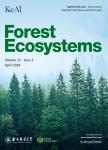Understorey species distinguish late successional and ancient forests after decades of minimum human intervention: A case study from Slovenia
Understorey species distinguish late successional and ancient forests after decades of minimum human intervention: A case study from Slovenia作者机构:University of MariborFaculty of Natural Sciences and MathematicsKoroska c.1602000MariborSlovenia
出 版 物:《Forest Ecosystems》 (森林生态系统(英文版))
年 卷 期:2023年第10卷第1期
页 面:92-101页
核心收录:
学科分类:0907[农学-林学] 08[工学] 0829[工学-林业工程] 09[农学]
基 金:financial support within the research programs P1-0403 and J1-2457 funded by the Slovenian Research Agency
主 题:Forest community Successional forest Indicator plants Plant diversity Understorey Geophytes
摘 要:The main species composition drivers in temperate deciduous forests are environmental conditions, a stand?s age and the site history, e.g., the succession stage and past land use, as well as disturbance regime and current management. We compared plant species diversity and composition in late successional and ancient forests, cooccurring on the same small river island applying species accumulation curves and nonmetric multidimensional scaling, respectively. Given the island?s geomorphological characteristics, we expected these to be very similar before human intervention in the past. The forests experienced differing disturbance regimes in the past, while over the last 30 years, human intervention has been the same and reduced to a minimum. The ancient forest in this study had two major characteristics defining it as old, mature forest: continuity of presence for more than 200years and specific composition. The late successional forest experienced major disturbance in the 20th century and was allowed natural regeneration by bordering on the ancient forest, representing a potential species pool,and by decades of minimum human intervention. Our results showed that, even though there was no difference in species richness, we could still detect differences between the forests, particularly in the abundance and species composition of the understorey, among which geophytes had the most indicative importance. To make our results useful on a broader scale, we composed from the literature a species list of plants indicative for ancient forest and tested its application. These results are important for distinguishing between old and mature secondary stands and particularly for identifying old forest stands, which should be conserved and, in the case of fragmented landscapes, included in a network connecting forest fragments.



